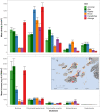Spatial and seasonal variation in macrozoobenthic density, biomass and community composition in a major tropical intertidal area, the Bijagós Archipelago, West-Africa
- PMID: 36441788
- PMCID: PMC9704600
- DOI: 10.1371/journal.pone.0277861
Spatial and seasonal variation in macrozoobenthic density, biomass and community composition in a major tropical intertidal area, the Bijagós Archipelago, West-Africa
Abstract
The coastal intertidal ecosystem of the Bijagós Archipelago, Guinea-Bissau, one of the largest and most important in West Africa, sustains a considerable proportion of the migratory shorebird populations of the East Atlantic Flyway and operates as a nursery area for benthic fish in the region. The macrozoobenthos in these mudflats constitute the main food source for both groups so that spatial and temporal variation in their abundance and community composition is likely to influence the abundance and distribution of fish and birds. In this study we described the spatial and temporal dynamics in the density, biomass, and community composition of macrozoobenthos across six intertidal flats in three islands of the Bijagós Archipelago. Overall, the Bijagós Archipelago was characterised by a highly species-rich macrozoobenthic community, with ca. 88 taxa identified across all sites, reaching a mean density of 1871 ± 58.3 ind.m-2 (mean ± SE) and mean biomass of 5.65 ± 0.41 g of AFDM.m-2 (ash-free dry mass per m2), values much lower than what was described for nearby intertidal areas, namely the Band d'Arguin, Mauritania. Density and biomass of major macrozoobenthos classes (Bivalvia, Polychaeta, Malacostraca and Gastropoda) differed across sites and months, displaying an overall increase in density towards the final months of the dry season (March and April). Similarly, community composition also differed significantly between sites and throughout the season. The site with most distinct community composition (Adonga) supported low diversity and high abundance of a few bivalve species, whilst other two sites that hosted the most diverse communities, were also the most similar between them (Anrumai and Abu). These spatial and temporal patterns constitute an important baseline to improve knowledge of this intertidal ecosystem and will contribute towards a better understanding of the spatial and temporal distribution patterns of their consumers.
Copyright: © 2022 Coelho et al. This is an open access article distributed under the terms of the Creative Commons Attribution License, which permits unrestricted use, distribution, and reproduction in any medium, provided the original author and source are credited.
Conflict of interest statement
The authors have declared that no competing interests exist.
Figures






References
-
- Finlayson C, Milton G, Prentice R, Davidson N. The wetland book. II. Distribution, description and conservation. Dordrecht: Springer; 2017.
-
- Beninger PG. Mudflat Ecology. Aquatic Ec. Beninger PG, editor. Cham: Springer International Publishing; 2018. doi: 10.1007/978-3-319-99194-8 - DOI
-
- Arkema KK, Guannel G, Verutes G, Wood SA, Guerry A, Ruckelshaus M, et al.. Coastal habitats shield people and property from sea-level rise and storms. 2013;3. doi: 10.1038/NCLIMATE1944 - DOI
Publication types
MeSH terms
LinkOut - more resources
Full Text Sources
Research Materials
Miscellaneous

